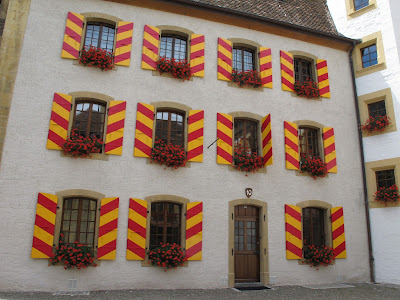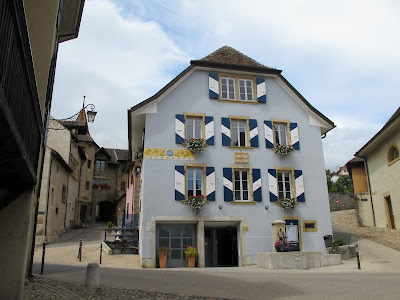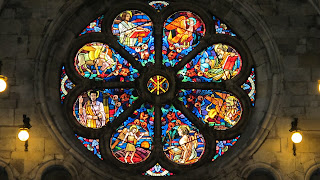Pilgrim Hall was abuzz with activity each morning this past
week. Heidi did a fine job of
organizing our outreach to children in Norwalk by making lunches each day for
the kids through Bridgeport Rescue Mission. There was a sandwich assembly line and a filling area with
175 brown bags each day ready to receive the sandwiches, a juice box, an apple,
and a snack.
Now someone had to figure out how many loaves of bread to
buy and how many packages of bologna to purchase because 175 times 5 is 875 bag
lunches that were needed. Luckily,
Justin was ready to compute it all out. 1,750 slices of bread were needed or rather 175 loaves of
bread excluding heals, as well as 1,750 slices of bologna, 875 pieces of
cheese, apples, juice boxes and snacks.
It all worked! For 5 days
175 kids enjoyed fresh lunches and we at WCC put our faith into action.
Let us now listen to another story of feeding from the
Gospel of John the 6th chapter.
After this Jesus went to the other
side of the Sea of Galilee, also called the Sea of Tiberius. A large
crowd kept following him, because they saw the signs that he was doing for the
sick. Jesus went up the mountain and sat down there with his disciples. Now the
Passover, the festival of the Jews, was near. When he looked up and saw a large
crowd coming towards him, Jesus said to Philip, ‘Where are we to buy bread for
these people to eat?’ He said this to test him, for he himself knew what he was
going to do. Philip answered him; ‘Six months’ wages would not buy enough bread
for each of them to get a little.’
One of his disciples, Andrew, Simon
Peter’s brother, said to him, ‘There is a boy here who has five barley loaves
and two fish. But what are they among so many people?’ Jesus said, ‘Make the
people sit down.’ Now there was a great deal of grass in the place; so they sat
down, about five thousand in all. Then Jesus took the loaves, and when he had
given thanks, he distributed them to those who were seated; so also the fish,
as much as they wanted. When they were satisfied, he told his disciples,
‘Gather up the fragments left over, so that nothing may be lost.’ So they
gathered them up, and from the fragments of the five barley loaves, left by
those who had eaten, they filled twelve baskets. When the people saw the sign
that he had done, they began to say, ‘This is indeed the prophet who is to come
into the world.’
When Jesus realized that they were
about to come and take him by force to make him king, he withdrew again to the
mountain by himself.
When evening came, his disciples
went down to the lake, got into a boat, and started across the lake to
Capernaum. It was now dark, and Jesus had not yet come to them. The lake became
rough because a strong wind was blowing. When they had rowed about three or
four miles, they saw Jesus walking on the lake and coming near the boat, and
they were terrified. But he said to them, ‘It is I; do not be afraid.’ Then
they wanted to take him into the boat, and immediately the boat reached the
land towards which they were going.
Looks like the disciples too, initially, were trying to
compute the cost of feeding so many people. They needed figure out the dilemma that Jesus posed to them,
‘Where are we to buy food for these people to eat?’ Well Philip didn’t need
Justin to compute the cost to feed those 5,000 very hungry people on the side
of the mountain by the Sea of Tiberias.
He was right spot on; he went right into the computing mode, why “Six
months wages wouldn’t even be close to buying enough bread for the
people.” All Philip knew was that
they needed a lot of bread. That
would be an awful lot of sack lunches – according to Justin’s figures it would
amount to 10,000 pieces of bread and bologna (or fish) to make 5,000
sandwiches.
Then Simon Peter’s brother Andrew noticed there was a boy
who had five barley loaves and two fish.
You might think that he had trust that Jesus would come through, yet he
too questions Jesus, ‘What good are only five loaves and two fish that this
little boy has?’ It just didn’t
compute in Andrew’s mind how they would possibly feed all of these people with so
very little.
Feeding the Five Thousand by John Reilly
The feeding of the 5,000 people is one of the most familiar
and beloved stories that is recorded in all four of the Gospels. John’s Gospel was the last to be
recorded and is different than the other Gospel’s on a couple of levels. In John Jesus tells no discernable
parables like he does in the other Gospels and he talks extensively about
himself making the famous ‘I Am’ statements. And John refers to Jesus miracles as ‘miraculous signs’
conferring a very high Christology on Jesus; that Jesus is the risen Christ,
Son of God. It makes reading
John’s Gospel quite poetic and beautiful and it elevates Jesus to a much
greater divine level than the other Gospels.
In our reading today John has linked two Galilean miracle
stories together. They are two
stories that speak to our deepest human needs; our need for food and our need
for protection from harm. If we
were Abraham Maslow we would immediately identify these needs at the base of
his hierarchy of human needs: physiological and then safety. In his hierarchy one needs to be
grounded, before one can become an individuated adult, in other words, basic
needs must be met first. You can’t
determine your life’s course when you are so starved and can only think about
where and when your next meal will come from.
John, Andrew or Philip didn’t have Maslow or his hierarchy
chart; they didn’t have a clue about modern psychology. They just knew that people had needs
and that Jesus could fulfill those needs if he so chose to, and of course he
did. The disciples, and 5,000
people were able to witness God’s almighty power through Jesus Chris through
fish and loaves.
We too witnessed the power of Christ through our actions but we didn’t
come close to feeding 5,000. 175 children seems significant when you are
slapping those sandwiches together although, and unfortunately, we were able to
help just a very minute portion of this region’s hungry children. The statistics from End Hunger
Connecticut[i]
are staggering. Connecticut has
the third highest median income of all the states yet 11.7% of our children
live in poverty. That translates
to 94,985 children so the 175 children that we fed is merely a proverbial drop
in the bucket or 0.18%, not even one percent.
11.4% of Connecticut residents are ‘food insecure’ and 4.6% are VERY
‘food insecure’. We are last in
the nation for the percentage of schools with a school breakfast program at only
58.4% of schools that participate.
It is hard to believe that so many children go to bed hungry at night in
this well endowed State or even just next door in Norwalk. How can one be
educated, or work or play even a day without food to sustain them? And sadly, who can possibly compute the
mental and spiritual toll that physical hunger will take over time on a child
or person, or any sort of hunger for that matter.
This is why it was so vitally important for us to actually make
sandwiches this week. It was Desmond Tutu who said, “When people were hungry, Jesus didn't
say, "Now is that political, or social?" He said, "I feed
you." Because the good news to a hungry person is bread."[ii] Jesus met the 5,000 exactly where they
were. And they were tired and
hungry. He told them to sit down
on the hillside and he fed them, real food. Not rocket science, not a social or political statement.
Although we know that hunger now does have a political and
social side to it and we cannot close our eyes to it. We know that there is enough food in the world and for
heavens sakes in our community.
That’s not the problem. The
problem is distribution of food and aid to those in need. While we have no obligation to give aid
can we morally turn a blind eye to starvation and hunger when it is presenting
itself at our doorstep or when we know that it is widespread through the world?
I think not.
When opportunities like this past week emerge our initial
question should not be, ‘Should we do this’ rather it must be “How can we best accomplish
this?’. This is the Gospel truth.
Hunger, scarcity, fear. That’s what the people and the disciples were experiencing
when Jesus comes to their aid. Jesus
comes to heal, he comes to feed, and he comes to assuage fear and he
accomplishes this through five barley loaves and two fish. Never doubt for a moment that when left
up to God, a lot can be accomplished through so little. 875 bag lunches were our beginning but
it doesn’t have to be our end.
The apostle Paul said to the people at Ephesus, “His (Jesus)
power at work in us can do far more than we dare ask or imagine. (Eph. 3:20
CEV) If we allow the ultimate
power of God through Jesus Christ filter through our hearts and our hands we
can imagine to do just about anything.
Certainly we can imagine 5,000 people being fed that day on the sunny
mountainside overlooking the Galilee with plenty to spare for yet others.
Feeding of the 5,000 by Justino Magalona
May the great good news of Jesus Christ rest in your heart
this day.
Amen.




























































